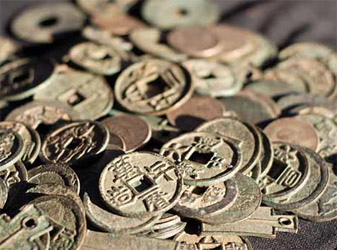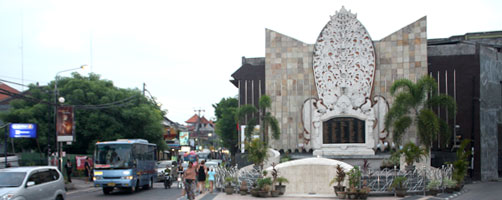Called Pis Bolong in Balinese and uang kepeng in Bahasa Indonesia, these living relics render a ceremony celebration incomplete without their presence. Ancient Chinese coins with square holes in the center and Chinese characters on the sides are all over in Bali.
The presence of coins in rituals has become somewhat compulsory. Meanwhile, the stock of coins has seen a decrease. It is no wonder, for as the population grows more people conduct rituals and the demand for coins rockets sky-high. During certain rituals such as ngaben cremations or rituals for the butha kala or lower deities, the coins cannot be reused.
This increase has led to people making duplicates. The duplicates are far different from the original ancient Chinese coins. The sizes are smaller, they are thinner, and the Chinese characters have almost disappeared. These rough imitations can be found easily in traditional markets. The price is much cheaper than the original. People pay Rp. 1,500 per coin for the original, while they only pay Rp. 200 per coin for the imitation version.
The imitations are selling well in the market as many buy them because they have no choice. For some people, ‘cheap’ can be the main reason because in a small ritual in a small temple the number of coins needed may amount to thousands of rupiah. The amount for Chinese coin purchases can be among the ‘big buys’ in a ritual.
This took place in the village of Tojan in the Klungkung regency, where the factory and showroom is positioned together as UD Kamasan Bali. The factory mass-produces coins for rituals and accessories. The building has metal merging and forging in the basement, accessory creation on the top floor, and the showroom is in the front.
This factory makes different versions from the original Chinese coins, and the coins are produced by five different metals known as Panca Datu or ‘five strengths of life’. They include iron, silver, copper, gold, and bronze. Respectively, the materials have special meanings and potencies.
The Balinese characters also show special significance and strengths. They replace the Chinese characters that mostly note the issuing dynasty’s name. Nowadays, the words ‘Sa’, ‘Ba’, ‘Ta’, ‘A’ can be seen beside every side of the square center hole. Again, the four of them represent the strength in four corner points of the compass. Over the letters, a padma, the symbol of the holiness is depicted.
Its processing also incorporates a quite unique method of gathering household leftovers. I Made Sukma Swacita, the manager of UD Kamasan Bali, said that they have indeed gathered materials like broken taps, second-hand irons, etc. Apart from helping to clean the environment, they also did not want to depend on materials that were offered to the factory.
Today, many people are already using the Balinese versions of the Chinese coins. Despite this, its presence is not suddenly a shift from the real Chinese coins. It is already four years passed but in many rituals Chinese coins can still be found.







